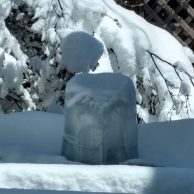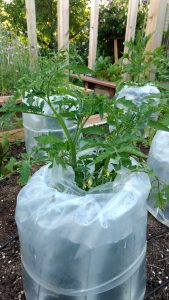 Unexpected cold snaps can still occur even after the last average frost date (around May 9). Just as we need to add another layer of clothing during cold snaps, our warm-season veggie starts also need additional insulation as the spring season and soil slowly begin to warm up. This layering can come in several forms, each with their own advantages and applications: low-tech overturned plant pots, row cover anchored over wire or plastic pipe frame (as illustrated in the “Hardening-Off” portion of this article), and Solar Caps.
Unexpected cold snaps can still occur even after the last average frost date (around May 9). Just as we need to add another layer of clothing during cold snaps, our warm-season veggie starts also need additional insulation as the spring season and soil slowly begin to warm up. This layering can come in several forms, each with their own advantages and applications: low-tech overturned plant pots, row cover anchored over wire or plastic pipe frame (as illustrated in the “Hardening-Off” portion of this article), and Solar Caps.
Because of their versatility and re-usability, Solar Caps have been one of our favorite garden tools for over a decade.

A Solar Cap consists of a sturdy, reusable metal frame that is anchored in the soil surrounding your warm-season veggie start (such as tomatoes, squash, peppers, etc.) and a water-filled bag that drapes over the outside of the frame. As the sun warms the water, heat radiates out to warm the soil, providing a terrarium-like environment for the veggie start to take root and begin thriving. Eve demonstrates the step-by-step process to putting together your Solar Cap. Solar Caps can also be left in place around tomatoes throughout the growing season to provide protection from temperature fluctuations on summer and autumn nights, thereby extending your growing season.
Another important reminder is that continued heavy winds contribute to foliage and soil desiccation. So be sure to provide additional watering to help your plants withstand these conditions.
